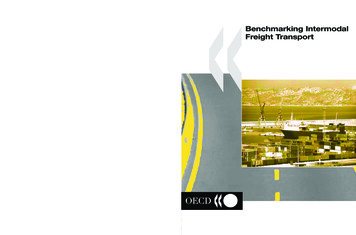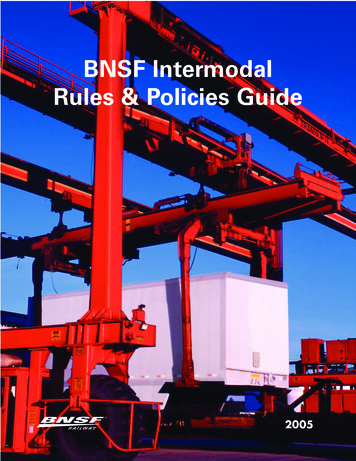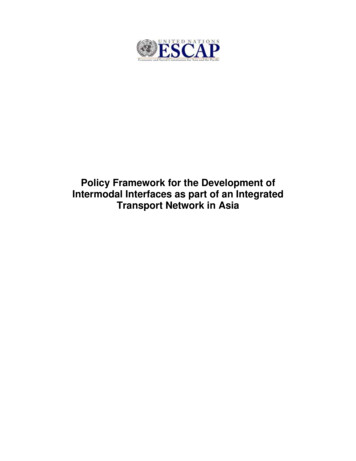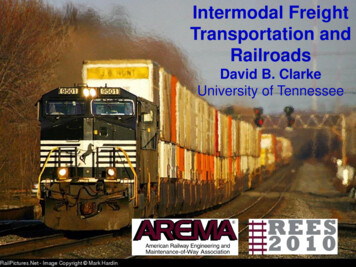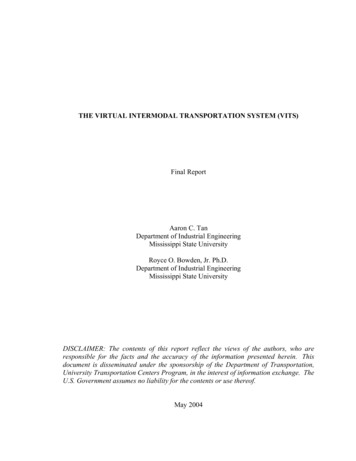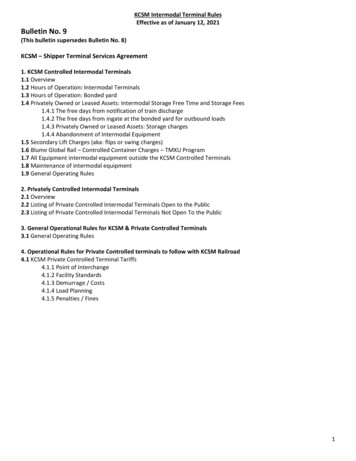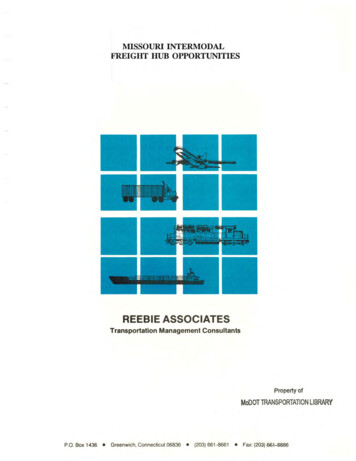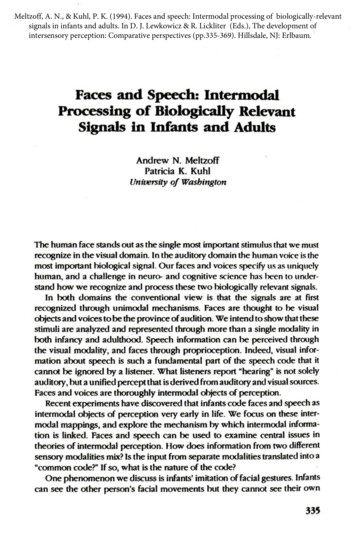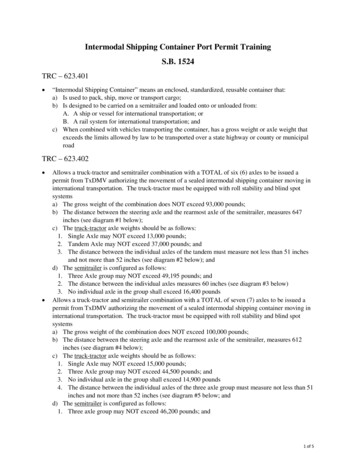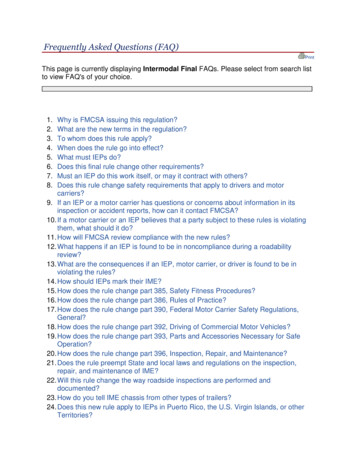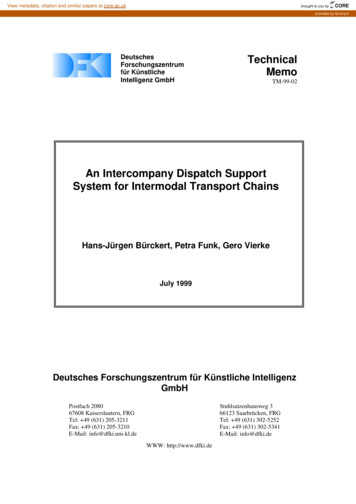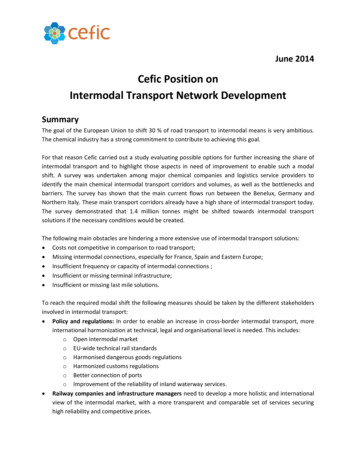
Transcription
June 2014Cefic Position onIntermodal Transport Network DevelopmentSummaryThe goal of the European Union to shift 30 % of road transport to intermodal means is very ambitious.The chemical industry has a strong commitment to contribute to achieving this goal.For that reason Cefic carried out a study evaluating possible options for further increasing the share ofintermodal transport and to highlight those aspects in need of improvement to enable such a modalshift. A survey was undertaken among major chemical companies and logistics service providers toidentify the main chemical intermodal transport corridors and volumes, as well as the bottlenecks andbarriers. The survey has shown that the main current flows run between the Benelux, Germany andNorthern Italy. These main transport corridors already have a high share of intermodal transport today.The survey demonstrated that 1.4 million tonnes might be shifted towards intermodal transportsolutions if the necessary conditions would be created.The following main obstacles are hindering a more extensive use of intermodal transport solutions: Costs not competitive in comparison to road transport; Missing intermodal connections, especially for France, Spain and Eastern Europe; Insufficient frequency or capacity of intermodal connections ; Insufficient or missing terminal infrastructure; Insufficient or missing last mile solutions.To reach the required modal shift the following measures should be taken by the different stakeholdersinvolved in intermodal transport: Policy and regulations: In order to enable an increase in cross-border intermodal transport, moreinternational harmonization at technical, legal and organisational level is needed. This includes:o Open intermodal marketo EU-wide technical rail standardso Harmonised dangerous goods regulationso Harmonized customs regulationso Better connection of portso Improvement of the reliability of inland waterway services. Railway companies and infrastructure managers need to develop a more holistic and internationalview of the intermodal market, with a more transparent and comparable set of services securinghigh reliability and competitive prices.
Intermodal operators and logistics service providers need to optimise the transparency ofintermodal solutions to their customers and increase collaboration among each other to enable newintermodal connections that are necessary to further push intermodal transport.Chemical companies need to take a more active role in evaluating the most sustainable and efficientmode of transport for each corridor and define expectations and objectives to their respectiveservice providers. Their willingness to increase the share of intermodal transport should bedemonstrated by actively supporting the development of intermodal alternatives.BackgroundOne of the most prominent targets in the EU Transport White Paper is the ambition to shift 30% of roadfreight over 300 km to other modes such as rail or waterborne transport by 2030, and more than 50% by2050. The goal is to facilitate this by efficient and green freight corridors. To meet this goal the EU hasrecognized that this will require the development of appropriate infrastructure , concluding thatdevelopment efforts “should focus on the completion of missing links – mainly cross-border sectionsand bottlenecks/bypasses – and the upgrading of existing infrastructure and development of multimodalterminals at sea and river ports”.Chemical companies have to a large extent already captured current intermodal transport opportunities,finding it difficult to further increase modal shift without jeopardizing service levels, being eitherconstrained by lack of capacities, lack of sufficiently developed routes, lack of reliability, lack of servicesat competitive rates or a combination thereof.A Cefic Issue Team composed of representatives from the chemical industry and the logistics industryand supported by SGKV (Studiengesellschaft fuer den Kombinierten Verkehr e.V., Germany) carried outa study to identify current and expected intermodal flows of the chemical industry throughout Europeand the main barriers for using more intermodal transport.Barriers hindering a more extensive use of intermodal transportChemical companies and logistics service providers believe that a further increase of intermodalsolutions for current and future transport flows can only be achieved if considerable efforts areundertaken to ensure that intermodal transport services better meet industry requirements andbecome a true and efficient alternative to road transport.The main obstacles that hinder more use of intermodal solutions are: High costs: The cost structure of intermodal transport, when compared to road transport, is themost important reason that prevents further shifts from road to intermodal solutions. Missing intermodal connections: There is still a significant lack of intermodal connections, inparticular in France and Spain. Insufficient frequency or capacity of existing intermodal connections, in particular in NorthernItaly, Southern France and South-Eastern Europe. Last mile (on-carriage trucking) solutions insufficient or missing: The last leg of intermodaltransport is a very complex field when it comes to quality, safety and costs. Finding the right
partner for the transport on the last leg may be especially difficult, in particular for hazardous ortemperature sensitive cargo.Insufficient or missing terminal infrastructure: The terminal infrastructure is considered to beat its limit and further capacities need to be created to make more intermodal transportspossible. Insufficient terminal capacities result in long waiting times and can result in latedeliveries. Major terminals along the axes between Benelux / Germany and Northern Italy needmore capacity to deal with additional volumes. New terminals are also needed to furtherdevelop the intermodal market to the CEE countries and Russia.A consistent implementation strategy at national and EU level is necessary to realize more crossborder transport. The rail transport market today is considered to be dominated by nationalinterests preventing the further development of cross-border operations. A cross-borderapproach for developing intermodal transport solutions and further harmonization in technicaland legal matters are needed.On-time reliability of intermodal services: To be competitive on-time reliability must becomparable to road transport.A lack of customer orientation resulting in missing transparency and lack of information.The availability of information on the detailed status of every transport operation would lead toa higher acceptance of intermodal alternatives.Missing focus on barge transport: At this moment both service providers and the chemicalindustry focus on rail and short-sea-shipping transport for intermodal solutions. Intermodalbarge transport is limited to dedicated solutions for specific single transport chains or toconnection with deep sea ports.Recommendations for increasing the intermodal shareThe chemical industry has a strong interest in shifting volumes to sustainable intermodal transport. Thegoal of the European Union to shift 30 % of transport from road to intermodal can only be achieved witha combined effort of all parties involved. Given the market situation for intermodal transport in Europe,significant further intermodal shifts will not be possible in the current environment. For that reasonmeasures from different parties (policy makers and regulators, railway companies, infrastructuremanagers, intermodal operators, logistics service providers and chemical companies) are necessary toreach this goal. The development of a single, Europe-wide intermodal market must be the main target ofall actions of the different parties.Policy and regulationsIn order to enable an increase in cross-border intermodal transport, more international harmonizationat technical, legal and organisational level is needed to ensure interoperability. Public funding should befocusing on the development of intermodal infrastructure, creating equal market conditions for everytransport mode.
The following issues will need to be addressed: Open intermodal market: In the current situation national rail companies (rail operators andinfrastructure managers) still play a key role in the intermodal market. To achieve a significantshift to intermodal transport, there is a need of a more transparent, customer-orientedapproach. Further liberalisation of the railway market in practice is necessary to enable morecompetition between the railway companies, so that the market becomes more customeroriented. EU-wide technical rail standards: Create a unified legal framework for intermodal transportwithin the EU. Consistent technical parameters (e.g. gauges, train lengths, total train weight,weight of wagons, security, noise, etc.) are needed throughout Europe, as well as a standardizedcertification of railway rolling-stock for cross-border acceptance resulting in completeinteroperability of services. Harmonised dangerous goods regulations: Regulations for the handling and storage ofdangerous goods need to be harmonised throughout Europe (e.g. a standardized minimumstorage time allowance of at least 48 hours). Also, dangerous goods regulations for short- seatransports need to be further harmonised with ADR. Harmonized customs regulations: The documentation procedures for transporting goods needto be further harmonised, so that a more reliable planning of the logistics supply chain ispossible. This especially applies to non-EU countries. Today, short- sea transports are in manycases still handled the same way as deep- sea shipments. Introduction of paperless systemsshould be supported. Better connection of ports: Sea ports are the backbone of international transport and especiallysuitable for intermodal hinterland transport strategies. Current actions to increase theconnectivity of ports, like the TEN-T approach, investments in rail infrastructure, etc. need to beenforced to raise additional capacity and more competitive services. Strategies to increase the efficiency of intermodal transport need to be further explored, e.g.the possibility of heavier and longer trains. In this context, authorized weights of up to 48tonnes for intermodal road transport need to be considered. Improvement of inland waterways transport services: In order to increase the utilization ofbarge solutions, proper maintenance and development of the existing infrastructure is needed,as well as the realisation of missing infrastructure, along with sufficient funding.Railway companies / rail infrastructure managersTo attract additional market potential, railway companies, infrastructure managers and terminaloperators will need to develop a more holistic and international view of the intermodal market, with amore transparent and comparable set of services securing high reliability and competitive prices.Efficiency of terminal handling should be increased by more standardisation of the terminal design. Ifterminal modules follow the same standard, they may become interchangeable, which may be helpfulwhen planning a network of intermodal terminals, resulting in a more efficient use of their capacity andservices.
Railway companies and infrastructure managers need to develop methods to facilitate cross-borderintermodal transport, e.g. IT-solutions for tracking and tracing of intermodal loading units with openstandards for data exchange or more flexible logistical concepts in cross-border transports. Also, moreefficient logistics systems, such as hub-and-spoke terminal network strategies, need furtherdevelopment in the rail sector.Longer trains, more capacity (loading units, vehicles) and higher departure frequencies should make theintermodal system more competitive.Also, more investment and further development of infrastructure (i.e. terminals, wagons, tracks) isneeded.Intermodal operators and logistics service providersIntermodal operators and logistics service providers need to optimise the transparency of intermodalsolutions to their customers and increase collaboration among each other to enable new intermodalconnections that are necessary to further push intermodal transport.Intermodal operators and logistics service providers should optimise the transparency of intermodalsolutions to their customers, so that the choice of the appropriate transport mode is made easier.Increased collaboration among service providers to enable new intermodal connections, as well asbetween the logistics companies and their customers, may help develop networks that have a bettermarket position towards the supply side.IT solutions that provide real time information about the status of shipments during the entire transportchain will prove inevitable in the further development of reliable, flexible and competitive intermodaltransport solutions.Chemical companiesChemical companies have always been supportive of intermodal transport, favouring intermodaltransport options over pure road transport where available and feasible.Since intermodal operators generally do not have direct (contractual) relationships with chemicalcompanies, they are lacking visibility of both potential demand and expectations. Chemical producersshould take therefore take a more proactive role in strategic planning discussions, to give logisticsservice providers and in particular intermodal operators more visibility of their intermodal transportdemand, in particular when it comes to strategic network planning of particular lines.Chemical companies, their logistics service providers and intermodal operators should come together atround table meetings, jointly exploring opportunities for further modal shift, concentrating theirdialogue on the further development of key strategic corridors where logistics service providers andintermodal operators are bundling demand of multiple chemical companies and shippers from otherindustries.
Intermodal operators and logistics service providers should optimise the transparency of intermodal solutions to their customers, so that the choice of the appropriate transport mode is made easier. Increased collaboration among service providers to enable new intermodal connections, as well as between the logistics companies and their .
